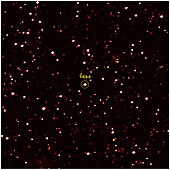TrES-2b
Template:Planetbox begin Template:Planetbox image Template:Planetbox star Template:Planetbox orbit Template:Planetbox character Template:Planetbox discovery Template:Planetbox catalog Template:Planetbox reference Template:Planetbox end
TrES-2b (or Kepler-1b) is an extrasolar planet orbiting the star GSC 03549-02811 located 750 light years away. The planet has been identified in 2011 as the darkest known exoplanet, reflecting less than 1% of any light that hits it.[1] The planet's mass and radius indicate that it is a gas giant with a similar bulk composition to Jupiter. Unlike Jupiter, but similar to many other planets detected around other stars, TrES-2b is located very close to its star, and belongs to the class of planets known as hot Jupiters. This system is within the field of view of the now operational Kepler spacecraft.[2]
This planet continues to be studied by other projects and the parameters are being improved continuously. A 2007 study improved stellar and planetary parameters.[3] Another 2008 study concluded that the TrES-2 system (along with two others) is a binary star system. This has a significant effect on the values for the stellar and the planetary parameters.[4]
Discovery
TrES-2b was discovered on August 21, 2006 by the Trans-Atlantic Exoplanet Survey (TrES) by detecting the transit of the planet across its parent star using Sleuth (Palomar Observatory, California) and PSST (Lowell Observatory, Arizona), part of the TrES network of 10–cm telescopes. The discovery was confirmed by the W. M. Keck Observatory on September 8, 2006, by measuring the radial velocity of the star that hosts TrES-2b.[2]
Spin-Orbit Angle
In August 2008 more details of the relationship between the parent star and the orbit of the planet were published. The orbit was determined to be tilted by −9° ± 12° from the stellar equator. The orbital direction was determined to be in the same direction as the star's rotation (prograde).[5]
The Kepler Mission

In March 2009 NASA launched the Kepler Mission spacecraft. This spacecraft is a dedicated mission to discover extrasolar planets by the transit method from solar orbit. In April 2009 the project released the first light images from the spacecraft and TrES-2b was one of two objects highlighted in these images. Although TrES-2b is not the only known exoplanet in the field of view of this spacecraft it is the only one identified in the first light images. This object is important for calibration and check-out.[6]
Darkest planet
The first important result from the Kepler Mission about TrES-2b is an extremely low geometric albedo, measured in 2011.[1] If the entire day-night contrast were due to geometric albedo, it would be 2.53%, but modeling suggests that much of this is dayside emission and the true albedo is much lower. It is estimated to be less than 1% and for best-fit model it is about 0.04%. This makes TrES-2b the darkest known exoplanet, reflecting less light than coal or black acrylic paint.[7] It is not clear why the planet is so dark. One reason could be an absence of reflective clouds such as those which make Jupiter so bright, due to TrES-2b's proximity to its parent star and consequent high temperature. Another reason could be the presence in the atmosphere of light-absorbing chemicals such as vaporized sodium, potassium or gaseous titanium oxide.[8] In general, hot Jupiters are expected to be dark, because "absorption due to the broad wings of the sodium and potassium D lines is thought to dominate their visible spectra." Apart from that of Kepler-7b (38±12%), albedo measurements for hot Jupiters have generally given only upper limits.[1]
References
- ^ a b c David M. Kipping; et al. "Detection of visible light from the darkest world" (PDF). Monthly Notices of the Royal Astronomical Society. Retrieved 2011-08-12.
{{cite journal}}: Explicit use of et al. in:|author=(help) - ^ a b O'Donovan, Francis T.; Charbonneau, David; Mandushev, Georgi; Dunham, Edward W.; Latham, David W.; Torres, Guillermo; Sozzetti, Alessandro; Brown, Timothy M.; Trauger, John T. (2006). "TrES-2: The First Transiting Planet in the Kepler Field". The Astrophysical Journal Letters. 651 (1): L61–L64. arXiv:astro-ph/0609335. Bibcode:2006ApJ...651L..61O. doi:10.1086/509123.
- ^ Alessandro Sozzetti; et al. (August 1, 2007). "Improving Stellar and Planetary Parameters of Transiting Planet Systems: The Case of TrES-2". The Astrophysical Journal. 664 (2): 1190–1198. Bibcode:2007ApJ...664.1190S. doi:10.1086/519214.
{{cite journal}}: Explicit use of et al. in:|author=(help) - ^ Daemgen, S.; Hormuth, F.; Brandner, W.; Bergfors, C.; Janson, M.; Hippler, S.; Henning, T. (2009). "Binarity of transit host stars — Implications for planetary parameters" (PDF). Astronomy and Astrophysics. 498 (2): 567–574. Bibcode:2009A&A...498..567D. doi:10.1051/0004-6361/200810988.
- ^ Winn, Joshua N.; Johnson, John Asher; Narita, Norio; Suto, Yasushi; Turner, Edwin L.; Fischer, Debra A.; Butler, R. Paul; Vogt, Steven S.; O’Donovan, Francis T. (2008). "The Prograde Orbit of Exoplanet TrES-2b". The Astrophysical Journal. 682 (2): 1283–1288. Bibcode:2008ApJ...682.1283W. doi:10.1086/589235.
- ^ "Kepler Eyes Cluster and Known Planet". NASA. 2009-04-16. Retrieved 2009-05-09.
- ^ "Coal-Black Alien Planet Is Darkest Ever Seen". Space.com. Retrieved 2011-08-12.
- ^ Baldwin, Emily (2011-08-11). "Exoplanet blacker than coal". Astronomy Now. Retrieved 2011-08-12.
